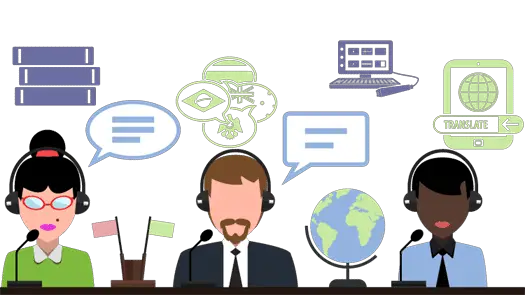
The term human translation highlights the fact that our translations are done by human beings instead of computers (a.k.a. machine translation).
As technology evolves more of the translation process is being delegated to software and computers. We agree that technology plays an important role in translation services. However, technology should be used as support to the human translation craft. While free Google translation may help you understand the main ideas contained in a piece of content written in another language, human translation is still a must when you need your content translated for your business or any other purpose requiring accuracy.
Humans in Charge of Context and Accuracy
Translation Context
Only humans can precisely decide what the right context for a text is. Words change meaning depending on the context, and the choice of a translation will rely heavily on the context. Keeping humans in charge of the overall management of the human translations will assure the translated document mirrors the original document
Slang, idiomatic expressions, localism, and technical domains are just a few other challenges to language translation automation. Language has some nuances that computers and artificial intelligence won’t be able to handle any time soon
Accuracy in Translation
There isn’t a single translation for a specific word. The best choice of which term will better convey the original meaning intended by the author will require a human being to make such a decision. Interesting to note that even professional translators will have different choices for terms and styles. Accuracy is not just technical. It is also an art that cannot be learned without decades of work behind a monitor. Translations to be used in court, business presentations, or any application requiring accuracy should be restricted to human translators to decades, if not centuries, to come.
Machines in Charge of Support and Repetition
Translation Support
Some activities during the translation process will be better accomplished by software instead of a human translator. Some of these translation support activities:
- retrieving a glossary during the translation process
- checking for spelling
- saving the translated document along the way
- providing advanced editing tools
- others
Repetition Savings
One of the most well-known advantages of using translation software is being able to leverage on repetition. It is quite common for segments of text to be repeated within a document or even a set of separate documents. Translation software can keep a ‘translation memory ‘of such repetitions and helping the translator by ‘pre-translating’ something he already translated in the past.
The main advantages coming from this ‘translation memory’:
- no need to translate the same thing multiple times
- consistency since a single translation will be provided for the same term
- savings in translation time and cost
- possibility of multiple human translators working on the same project while keeping consistency in terms of terminology choice
- development of a translation asset that can be kept over time independently of the human translators who have worked previously on the translation projects
Frequent Questions about Human Translations
1. Are there pure human translations being provided out there?
It is very rare to find a translator who doesn’t use some kind of technology when translating documents. Because of the competition in the translation services industry, we would say only amateur translators would work without some level of translation software to help them along the way.
2. What translation software do human translators use during their work?
The main tools used by translators in human translation are:
- CAT-Tools: these ‘computer-assisted translation tools’ focus on keeping a translation memory with the work being done by the translators for future use
- Text Editors: usually already built-in the CAT-Tools
- Electronic glossaries: so they can check the best terms for terminology or keep their work consistent with what was done previously
- Others
3. Will human translators become unnecessary in the future?
Not in our lifetime. We have heard many times that machine translation and would soon make human translators disposable. This prediction has not nearly materialized and we don’t believe it will any time soon.
Intelligent communication remains pretty unreachable to computers even the most powerful ones reserved only to large corporations and universities.
CAT-Tools (computer-assisted translation tools) have been evolving over time and becoming more and more necessary for the human translation craft. However, they are still a support-tool instead of a main component during the human translation process.
4. Do I really need a human translation? How can I tell?
Ask yourself if you can afford inaccuracies in your translation. Let’s say you just want to read a sales letter from a company abroad. In this case, a Google machine translation could give you a very good idea about the original meaning of the letter. And, if you need a better understanding of some passage, in particular, you can always hire a human translator to handle that specific passage. This would save you money since you wouldn’t need to translate the whole document.
On the other hand, if you are providing documents for immigration purposes or if you need your company brochures translated, you wouldn’t take the chances of providing less than accurate documents, right? It is all about the accuracy tolerance you are willing to assume.
- Less than perfect translations are acceptable for many applications while others will absolutely require accurate translations prepared by seasoned human translators.
Translation Context
Only humans can precisely decide what the right context for a text is. Words change meaning depending on the context, and the choice of a translation will rely heavily on the context. Keeping humans in charge of the overall management of the human translations will assure the translated document mirrors the original document.
Slang, idiomatic expressions, localism, and technical domains are just a few other challenges to language translation automation. Language has some nuances that computers and artificial intelligence won’t be able to handle any time soon.
Accuracy in Translation
There isn’t a single translation for a specific word. The best choice of which term will better convey the original meaning intended by the author will require a human being to make such a decision. Interesting to note that even professional translators will have different choices for terms and styles. Accuracy is not just technical. It is also an art that cannot be learned without decades of work behind a monitor. Translations to be used in court, business presentations, or any application requiring accuracy should be restricted to human translators to decades, if not centuries, to come.
A translation Services little Touches can make a Big Difference
Evaluating a translation service requires differentiating between translation companies which will merely transcribe data verbatim into a new language and those who will make your product shine in a new context.
On the whole, translation services that rely more heavily on humans than automated techniques provide a better experience for you and your customers.
What’s The Advantage of Professional Human Translations?
Professional human translation provides the flair that makes for a successful transition of your product to a new market.
Human translators are context-sensitive, culturally aware, capable of translating idioms, and capable of producing prose that is grammatically and semantically correct. Nonetheless, many translation services utilize automated translating methods.
According to an article published on The Verge, although automated translation systems may be approaching the quality of human translation in some contexts, they never reach the same quality as a professional human translator.
This is especially true when translating between highly divergent languages like English to Chinese or vice versa. In these contexts, the advantages of professional human translators are significantly larger than elsewhere.
When translating to or from a challenging language, human translators are more likely to avoid errors that would strike a native speaker as being obvious in comparison to automated translations.
Furthermore, the majority of translation services still have a significant professional human translation capacity, meaning that it’s typically easier to find a translation service if you’re using human translation as a selection criterion.
Finally, if you have specific instructions for your translators, the only thing that will satisfy you is a translation company with human translators. Automated translators tend to be inflexible to customer demands.
What’s The Disadvantage of Human Translations?
Despite these advantages, human translations aren’t perfect.
In a report published by Global Market Insights, data show that the machine translation market is growing and will surpass $1.5 billion by 2024. The majority of this growth will be in the defense, electronics, IT, and healthcare sectors.
This means that finding human translators in these fields may be more difficult moving forward. Likewise, it means that the accuracy of translations in these industries is continuing to improve, even if it will take a long time to surpass the accuracy of human translations.
Another issue with human translations is that the turnaround time may be longer. When human translators translate, they don’t merely transcribe the concepts from one language to another.
In fact, according to the Huffington Post, human translators must recreate the intent of the language. This makes them significantly slower in any given translation context.
It does, however, mean that translations performed by humans are more artful in terms of their language. This too can be a problem, however.
Humanized language means that translations can be extremely inconsistent between translators. One translator might come up with one sentence whereas another would come up with an entirely different sentence, portraying the same concept in a different light.
In contrast, machines offer a deterministic translation that is a bit less artful but is highly consistent, even when it’s incorrect.
How Can My Company Maximize The Benefits Of Human Translation?
Given these advantages and disadvantages of human translation and automated translating services, which is the best choice for your company?
How can your company get the most mileage out of the uniquely human flair that translation services provide without breaking the bank?
Answering these questions is a matter of understanding your needs. If you’re looking for a translation of highly technical material, you may be surprised to find that the importance of a human translator’s touch is more important than with material that is more subjective.
The reason behind this counterintuitive fact is that technical terms are often difficult to translate because they may not be literal.
In a highly subjective passage, like the transcript of an informal discussion between two people, an automated translation service can parse the meaning into a crude translation without much trouble. It may not appear graceful to read, but it would be possible to understand.
In contrast, something like a user manual does not have the same leeway. If an automated translation merely captured the gist of the contents of your user manual, you already know that your users would be clogging your customer service lines with complaints and questions.
When precision matters, a human translator’s touch is necessary to navigate the peculiarities of terms that don’t have literal translations into other languages.







